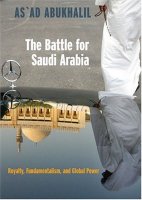"The dispute took a personal tone when lawyers for Qatar's first lady, Sheikha Mozah bint Nasser al-Missned, argued in a libel case she won against a London-based Arabic newspaper in 2005 that the paper was, as Dawn reported, "controlled by Saudi intelligence paymasters who used the newspaper as a mouthpiece for a propaganda campaign against Qatar and its leadership." In April 2008, the London-based, Saudi-owned Arabic daily Asharq Al-Awsat apologized for printing three "wholly untrue" articles back in 2006 alleging that Qatar's prime minister had visited Israel in secret.
During its decade of cold relations with Saudi Arabia, Qatar warmed up to Syria, the leader of the so-called resistance axis in Arab politics. Syrian President Bashar al-Assad and Qatari Emir Sheikh Hamad bin Khalifa al-Thani were frequent visitors to each other's countries, and Qatari investors poured billions of dollars into the struggling Syrian economy. Both states, along with Iran, Hezbollah, and Hamas, were seen as a regional counterbalance to the pro-Western axis of Egypt, Jordan, Saudi Arabia, and the United Arab Emirates. (The Saudis made their displeasure with Qatar's maverick policies clear on a number of occasions. Saudi Arabia, along with Egypt, refused to attend a January 2009 summit in Qatar supported by Syria and Hamas and instead held another summit in Riyadh just one day before.)
Wishing to put an end to the bad blood, Qatari Prime Minister Sheikh Hamad bin Jassim bin Jaber al-Thani, widely seen as the architect of Qatar's foreign policy, accompanied the emir on a surprise visit to Riyadh in September 2007. Relations quickly improved following that visit, with the Saudi monarch attending the Gulf Cooperation Council summit in Doha that December. By next March, the new Saudi crown prince, Sultan, had paid a three-day visitto Doha, the first since 2002. In July 2008, the Saudis played host to a high-level summit in Jeddah that saw the two neighbors demarcate their border and set up a joint council to be chaired by both states' crown princes -- who are more than 50 years apart in age -- to strengthen political, security, financial, economic, commercial, investment, cultural, and media relations." (thanks Sultan)
During its decade of cold relations with Saudi Arabia, Qatar warmed up to Syria, the leader of the so-called resistance axis in Arab politics. Syrian President Bashar al-Assad and Qatari Emir Sheikh Hamad bin Khalifa al-Thani were frequent visitors to each other's countries, and Qatari investors poured billions of dollars into the struggling Syrian economy. Both states, along with Iran, Hezbollah, and Hamas, were seen as a regional counterbalance to the pro-Western axis of Egypt, Jordan, Saudi Arabia, and the United Arab Emirates. (The Saudis made their displeasure with Qatar's maverick policies clear on a number of occasions. Saudi Arabia, along with Egypt, refused to attend a January 2009 summit in Qatar supported by Syria and Hamas and instead held another summit in Riyadh just one day before.)
Wishing to put an end to the bad blood, Qatari Prime Minister Sheikh Hamad bin Jassim bin Jaber al-Thani, widely seen as the architect of Qatar's foreign policy, accompanied the emir on a surprise visit to Riyadh in September 2007. Relations quickly improved following that visit, with the Saudi monarch attending the Gulf Cooperation Council summit in Doha that December. By next March, the new Saudi crown prince, Sultan, had paid a three-day visitto Doha, the first since 2002. In July 2008, the Saudis played host to a high-level summit in Jeddah that saw the two neighbors demarcate their border and set up a joint council to be chaired by both states' crown princes -- who are more than 50 years apart in age -- to strengthen political, security, financial, economic, commercial, investment, cultural, and media relations." (thanks Sultan)








